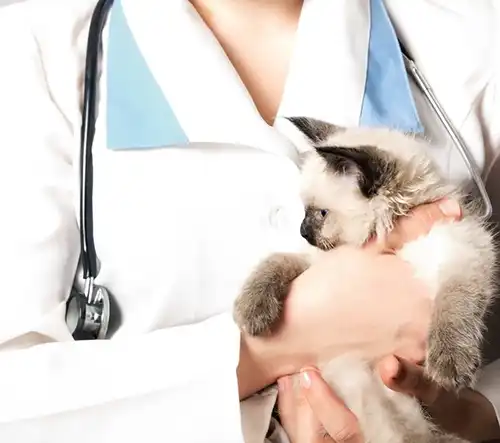Cats typically enter their senior years at around eleven years old. These days, cats frequently live well into their teens or even twenties. Our beloved feline friends tend to age with grace. You’re more likely to observe subtle, gradual shifts in their appearance and behavior than sudden, dramatic transformations. Just like elderly people, older kitties need to visit the doctor more often compared to their younger counterparts. A San Rafael, CA vet offers tips on how to take an older cat to the doctor in this article.
How Can I Safely Transport An Older Cat?
When you’re on the go, it’s always a good idea to ensure that Fluffy is securely contained in a crate or carrier. This keeps her safe and provides peace of mind for you, as you won’t have to worry about your furball crawling into your lap as you’re driving.
Add cozy bedding to make the carrier more inviting. You can also consider adding a beloved toy or treating your feline companion to catnip.
As cats age, they may experience stiffness and discomfort, especially if they have arthritis or other health issues. Fluffy may not enjoy being held. Be very careful when handling your beloved pet!
What Can I Expect as My Cat Gets Older?
As mentioned earlier, cats enter their senior years around the age of 11. An 11-year-old cat can still have plenty of energy and playfulness, with many years of purring and pouncing ahead of her. When your pet reaches around 15 years old, she will be considered geriatric.
You may notice Fluffy sleeping more, and perhaps not being as playful as she was. Your adorable companion might also look a bit disheveled. It can be challenging for older cats to groom themselves thoroughly. Plus, their fur tends to become oily. (Note: your feline pal may appreciate being brushed regularly.)
Our feline friends don’t all mature at the same rate. Certain cats may seem perfectly happy and healthy, only to suddenly deteriorate. Others may gradually experience the effects of illness, disease, or simply the passage of time.
Closely observe your feline pal and be alert for any signs of distress. These might be quite subtle! If you happen to notice anything out of the ordinary, please don’t hesitate to contact us right away.
How Can You Tell If Your Senior Cat Is Not Feeling Well?
Keep an eye out for symptoms such as weight loss, increased urination, stiffness, vomiting, diarrhea, increased thirst, litterbox troubles, and respiratory problems. It’s important to be aware of any shifts in behavior as well. When cats are sick or in pain, they may meow loudly or become very quiet. Your feline pal may also just not act like herself.
Another indication to be aware of is lethargy. Fluffy can sleep for up to 20 hours a day. However, if she seems to be sleeping all the time, there may be something wrong with her.
Contact your vet San Rafael, CA right away if you notice anything off.
How Often Should Fluffy Visit Her Veterinarian
There is no one-size-fits-all answer to this question; it will truly depend on Fluffy’s age, health, and lifestyle. We recommend bringing in older cats for regular check-ups on a yearly basis. If your furry companion has medical conditions, she may need to come in more often. Geriatric cats also require biannual visits.
What Are Some Common Health Issues In Seniors Cats?
Cats in their senior years are susceptible to many of the same health problems that affect elderly humans. Kidney disease is quite common, and is unfortunately a major cause of mortality in cats. Our senior patients are also susceptible to a wide range of common conditions, including diabetes, hyperthyroidism, cancer, heart disease, liver disease, osteoarthritis, and IBD (Inflammatory Bowel Disease). Another frequent concern is Feline Lower Urinary Tract Disease (FLUTD), which can lead to urinary blockage, bladder stones, and kidney problems.
It is also not uncommon to observe cognitive decline in older cats, even those that are otherwise in good health.
Although any cat can be affected by any of these illnesses, certain breeds are more prone to developing specific health issues. You may want to consider obtaining a cat DNA test.
Taking An Older Cat To Her San Rafael, CA Veterinarian
Fluffy probably won’t be any fonder of coming into the clinic than she was before. Given Fluffy’s preference for staying at home, she will likely be displeased if her nap schedule is disrupted. Man’s Second Best Friend also just generally doesn’t enjoy car rides. Cats can become quite anxious when they are taken away from their familiar surroundings.
You can do some things to make Fluffy’s journey more comfortable.
Offer A Cozy Carrier Everyone wants to ride in comfort!
Time It Right. If you want to schedule your appointment smoothly, it might be a good idea to choose a time when the clinic is less crowded. There is never a guarantee of a quiet day, as emergencies can happen at any time. However, certain times and days tend to be busier than others. Of course, if your pet is showing symptoms, you’ll need to bring her in right away.
Drive Carefully. Try to avoid sharp turns, bumps, and fast stops or starts.
What Happens At A Veterinary Appointment For Older Cats?
If Fluffy is only coming in for an exam and wellness care, the appointment will probably be quite routine. The veterinarian will evaluate the physical condition of your pet and monitor important indicators like pulse and breathing. In addition, they will provide you with information about any recommended immunizations or boosters that Fluffy may need.
Depending on her age and any symptoms she shows, an older cat may also need to undergo certain tests or panels.
An emergency appointment would of course be determined by what the issue is.
Taking an elderly cat to the doctor can be a daunting experience, especially when you’re unsure about what you’ll discover regarding your beloved pet’s health. Always remember that your top priority should be ensuring Fluffy’s comfort and happiness for as long as you can. Also, keep in mind that modern veterinary medicine can effectively treat or manage a wide range of medical conditions. Identifying and addressing any issues as early as possible is crucial for optimal results!
What Can I Do To Make Sure My Kitty is Comfortable At Home?
There are several steps you can take at home to ensure your beloved pet stays happy, healthy, and purring with joy.
First things first: giving your furry friend a well-balanced diet, a cozy living space, and a tidy litterbox will greatly contribute to their overall well-being. Fluffy will also need lots of toys and playtime. Playing with Fluffy not only keeps her physically active, but also provides valuable mental stimulation.
You can also make small adjustments to create a more senior-friendly environment in your home. Consider investing in pet ramps or steps to assist your feline companion in accessing her preferred resting spots. Additionally, night lights can help her get around the house during nighttime hours. Consult your veterinarian for specific guidance on your adorable pet’s evolving care requirements.
Lastly, ensure that Fluffy feels loved and secure. There’s something truly special about senior cats’ purrs!
Make An Appointment At Your San Rafael, CA Pet Clinic
Would you like to learn more about caring for an older cat, or perhaps schedule an appointment for your cat? Feel free to contact us at your San Rafael, CA animal clinic whenever you need assistance.







!Social Media Icons